


Pictured left: a cylindrical fatigue specimen.
Pictured right: cross section of a thin wall produced via LPBF. Note: light colored regions represent metal and black regions represent mount media.
Problem
The development of processes and material properties for additively manufactured (AM) parts is a significant challenge for the United States Air Force (USAF), particularly when thin wall features are desired. The inherent surface texture from the laser powder bed fusion (LPBF) processes are known to yield deviations in load-bearing surfaces when compared to nominal computer-aided design (CAD). The organic industrial base (OIB) needs cobalt-chromium (CoCr) process data to expand LPBF capabilities and enable solutions for applications containing thin wall conditions. Additionally, engineering and sustainment teams depend on AM testing projects such as thin wall testing to support tactical and operational readiness.
Objective
This material testing program seeks to expand the USAF CoCr material property dataset by characterizing material behavior in thin wall as-printed features. Defining the material allowables for these features is necessary to design and qualify parts with thin walls. This project demonstrates a methodology for characterizing thin wall features of additively produced material and defining the material allowables. Ultimately, the development of standard design allowables enables the design and certification of additively produced materials. This method allows for decreased development times and faster design iterations.
Technical Approach
Pedigree of the manufactured LPBF material will align with the existing USAF CoCr material dataset. The existing USAF material dataset characterized bulk material defined by wall thicknesses equal to or greater than 0.075 inch. GE Additive plans to print and characterize LPBF CoCr specimens with wall thicknesses less than 0.075 inch. Characterization will include low cycle fatigue testing to determine the impact on fatigue with decreasing wall thicknesses. In addition to varying the wall thickness, GE Additive intends to encompass multiple test temperatures aligned with the existing USAF material dataset.
Project Participants
Project Principal

Other Project Participants
- NCDMM/America Makes
Public Participants
- U.S. Department of Defense
